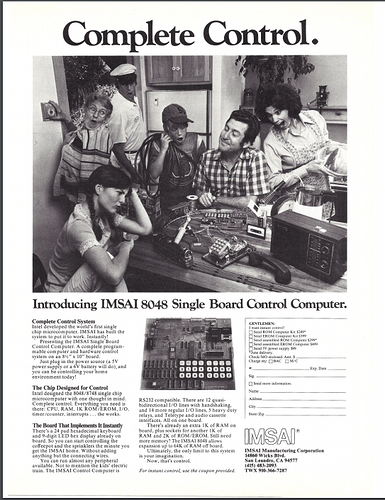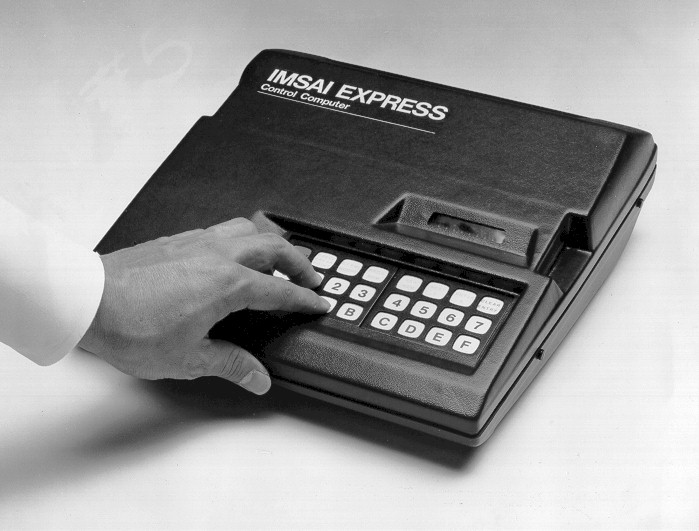Most of us are familiar with Imsai’s S-100 systems, but I ran across a really odd offering from them today. I found this ad in the May 77 issue of Kilobaud, pg 59.
Nice - that recurring dream of home automation!
Just plug in the power source (a 5V
power supply or a 6V battery will do), and
you can be controlling your home
environment today!The Chip Designed for Control
Intel designed the 8048/8748 single chip
microcomputer with one thought in mind.
Complete control. Everything you need is
there: CPU, RAM, IK ROM/EROM, I/O,
timer/counter, interrupts … the works.The Board That Implements It Instantly
There’s a 24 pad hexadecimal keyboard
and 9-digit LED hex display already on
board. So you can start controlling the
coffeepot and the sprinklers the minute you
get the IMSAI home. Without adding
anything but the connecting wires.You can run almost any peripheral
available. Not to mention the kids’ electric
train. The IMSAI Control Computer isRS232 compatible. There are 12 quasi-
bidirectional I/O lines with handshaking,
and 14 more regular I/O lines, 5 heavy duty
relays, and Teletype and audio cassette
interfaces. All on one board.There’s already an extra 1 K of RAM on
board, plus sockets for another IK of
RAM and 2K of ROM/EROM. Still need
more memory? The IMSAI 8048 allows
expansion up to 64K of RAM off board.Ultimately, the only limit to this system
is your imagination.
The very first “computer” I ever built from scratch was an 8048 (actually 8035) board. I still have it. Someday I’ll control my house with it  – or, at this rate, my room in the nursing home.
– or, at this rate, my room in the nursing home.
Found more information on this here: https://www.imsai.net/history/imsai_history/imsai_8048_control_computer.htm
Great find! Interesting that one of their targets was the model railway enthusiasts:
This was a limited production package for the IMSAI Express version of the 8048. It was targeted for the Model Railroad market and garnered much attention from the hobby community but, overall, was not successful. Fewer than 50 of these were produced.
There’s a deep connection to some of the first hacking activity at MIT:
When a piece of equipment wasn’t working, it was “losing”; when a piece of equipment was ruined, it was “munged” (Mash Until No Good); the two desks in the corner of the room were not called the office, but the “orifice”; one who insisted on studying for courses was a “tool”; garbage was called “cruft”; and a project undertaken or a product built not solely to fulfill some constructive goal, but with some wild pleasure taken in mere involvement, was called a “hack.”
McCarthy had a certain vision of what computers could do, and playing chess was only the beginning. All fascinating stuff, but not the vision that was driving Kotok and Samson and the others. They wanted to learn how to WORK the damn machines, and while this new programming language called LISP that McCarthy was talking about in 641 was interesting, it was not nearly as interesting as the act of programming
McCarthy in 1959 was turning his interest from chess to a new way of talking to the computer, the whole new “language” called LISP. Alan Kotok and his friends were more than eager to take over the chess project. Working on the batch-processed IBM, they embarked on the gargantuan project of teaching the 704, and later the 709, and even after that its replacement the 7090, how to play the game of kings. Eventually Kotok’s group became the largest users of computer time in the entire MIT computation center.
See also
The club’s members, who shared a passion to find out how things worked and then to master them, were among the first hackers. Some of the key early members of the club were Jack Dennis and Peter Samson, who compiled the 1959 Dictionary of the TMRC Language and who are credited with originating the concept “Information wants to be free”. The atmosphere was casual; members disliked authority. Members received a key to the room after logging 40 hours of work on the layout.
Around 1970, Digital Equipment Corporation donated two small rackmount PDP-11 minicomputers. One was eventually used to operate the club’s major freight yard and the other was set up to perform user interface tasks, such as initial assignment of trains to throttles, and to throw turnouts. The computer replaced the keypad unit from an old keypunch machine which had been originally installed by Richard Greenblatt.
The Tech Model Railroad Club also contributed crucially to tech and IT lingo, compare Peter Samson’s “TMRC Dictionary” (An Abridged Dictionary of the TMRC Language), 1st Edition 1959. Some of the definitions eventually found their way into the Jargon File:
2nd Ed., 1960: This is the second edition of the TMRC Dictionary
(If in despair for a canonical definition for crocks, gronkers or hacks, search no further!)
Edit:
The Video Game Historian / They Create Worlds has a nice writeup on the TMRC, “People Get Ready, There’s A Train A-Coming”: People Get Ready, There’s a Train A-Coming | They Create Worlds
(see also the article on Spacewar, the history of which is tightly interwoven with the TMRC, One, Two, Three, Four I Declare a Space War | They Create Worlds )

